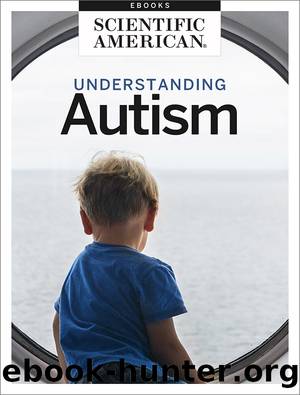Understanding Autism by Scientific American Editors

Author:Scientific American Editors
Language: eng
Format: epub
Publisher: The Rosen Publishing Group, Inc
Published: 2013-02-01T00:00:00+00:00
At least 16 of every 10,000 babies is born with autism or one of its related disorders. Since autism was first identified in 1943, scientists have made great strides in describing its symptoms. The biological basis for autism, however, has been elusiveâan unfortunate circumstance, because such an understanding could enable researchers to identify the leading risk factors for autism and possibly to design new treatments for the condition.
* * *
The Spectrum of Autism Disorders
A diagnosis of autism requires that the patient exhibit abnormal behaviors in three categories [see list] and have especially notable deficits in the category of social interaction. In addition, clinicians have identified several related disorders that share some of the behavioral features of autism but have different emphases or additional symptoms. For example, Pervasive Development Disorder, Not Otherwise Specified (PDD-NOS) denotes patients who miss fulfilling the autism criteria in one of the three categories. As is true of autism, PDD-NOS includes patients with the whole range of IQs. Asperger syndrome is used to describe patients with normal IQs and no evidence of language delay. Two much rarer diagnoses are Childhood Disintegrative Disorder, in which normal early development is followed by regression to severe disability, and Rett syndrome, a progressive neurological disorder that occurs only in females.
Although many scientists have long known that autism is an inherited disease, recent family studies by Peter Szatmariâs group at McMaster University in Ontario suggest that it is the spectrum of symptoms that runs in families rather than a single diagnosis. For example, a child with autism may have a brother with Asperger syndrome, or a woman with autism may have a nephew with PDD-NOS. These family studies strongly suggest that at least three of the diagnosesâautism, PDD-NOS and Asperger syndromeâarise from some of the same inherited factors.
Download
This site does not store any files on its server. We only index and link to content provided by other sites. Please contact the content providers to delete copyright contents if any and email us, we'll remove relevant links or contents immediately.
Kathy Andrews Collection by Kathy Andrews(11758)
The remains of the day by Kazuo Ishiguro(8885)
Paper Towns by Green John(5134)
Spare by Prince Harry The Duke of Sussex(5131)
The Body: A Guide for Occupants by Bill Bryson(5023)
Industrial Automation from Scratch: A hands-on guide to using sensors, actuators, PLCs, HMIs, and SCADA to automate industrial processes by Olushola Akande(5023)
Machine Learning at Scale with H2O by Gregory Keys | David Whiting(4256)
Be in a Treehouse by Pete Nelson(3996)
Never by Ken Follett(3874)
Harry Potter and the Goblet Of Fire by J.K. Rowling(3802)
Goodbye Paradise(3759)
Into Thin Air by Jon Krakauer(3344)
The Remains of the Day by Kazuo Ishiguro(3339)
Fairy Tale by Stephen King(3303)
The Cellar by Natasha Preston(3293)
The Genius of Japanese Carpentry by Azby Brown(3253)
120 Days of Sodom by Marquis de Sade(3222)
The Man Who Died Twice by Richard Osman(3036)
Drawing Shortcuts: Developing Quick Drawing Skills Using Today's Technology by Leggitt Jim(3035)
